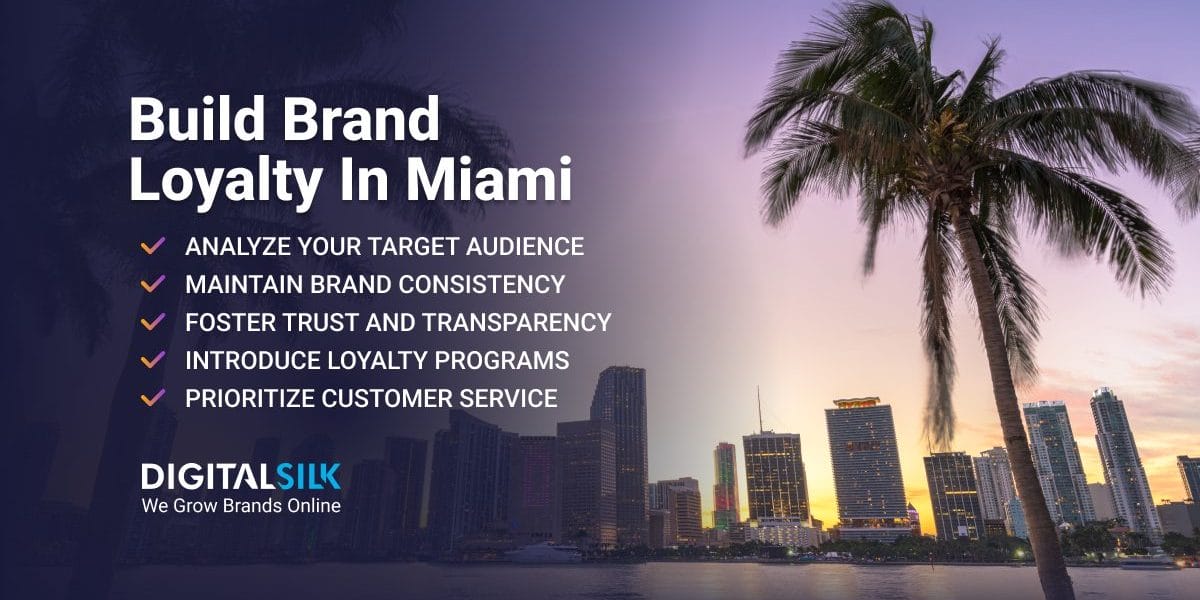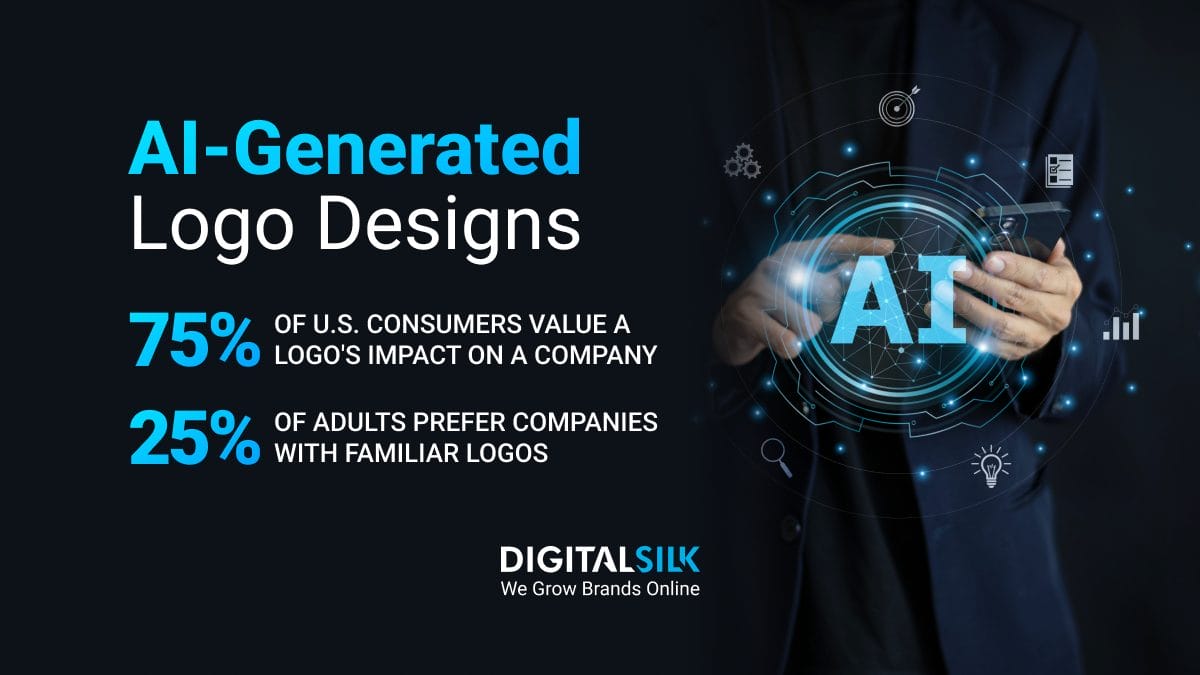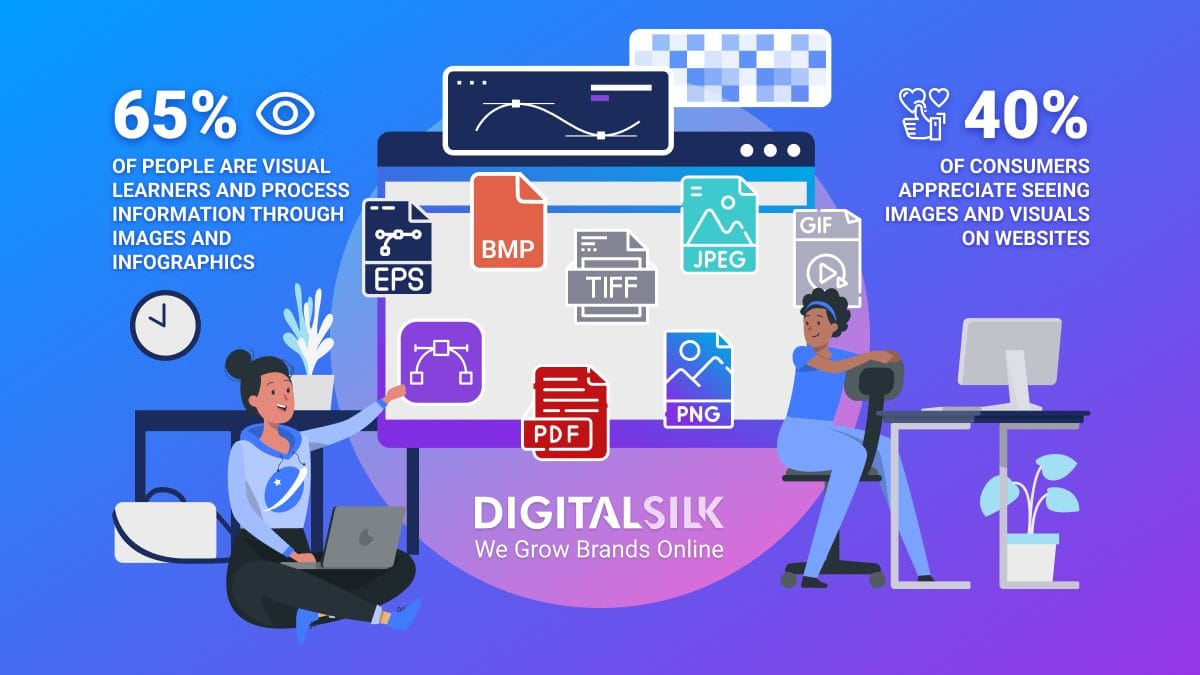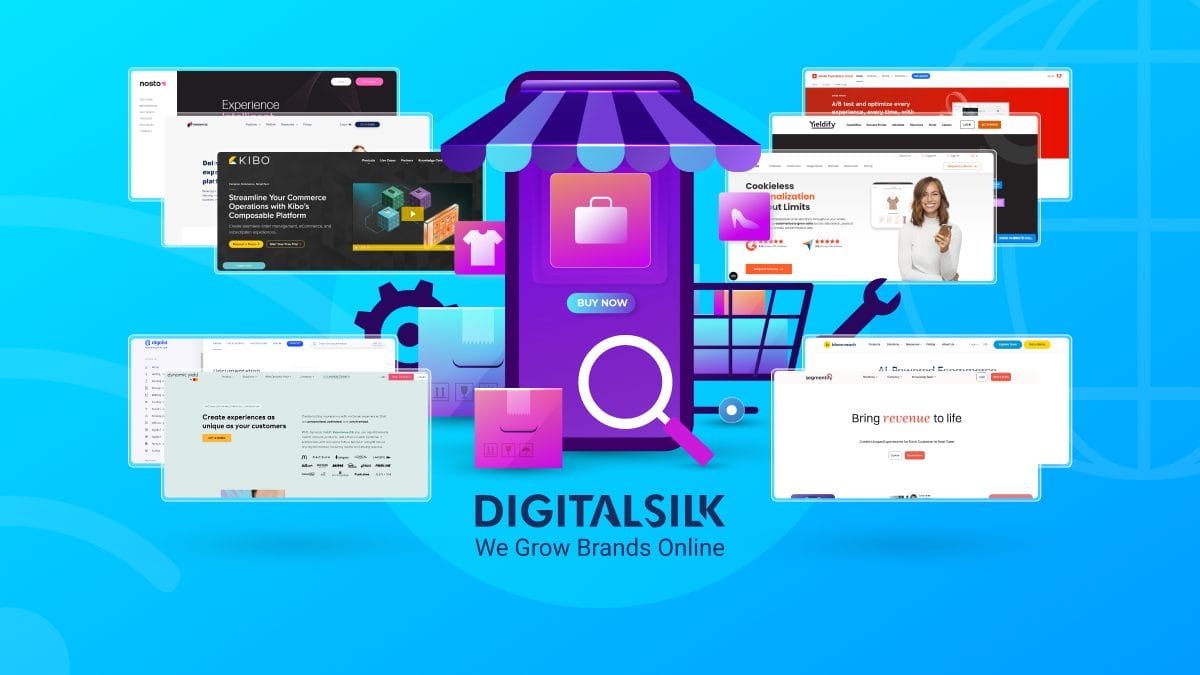“A brand for a company is like a reputation for a person. You earn reputation by trying to do hard things well.” — Jeff Bezos.
In a city as dynamic and culturally rich as Miami, communicating a compelling brand narrative that aligns with the community’s unique ethos is crucial for building consumer loyalty.
While 80% of U.S. consumers feel loyal to a particular brand or company, building that trust from the ground up requires a strategic approach.
In this post, we’ll examine the basics of building brand loyalty in Miami, offer practical tips for nurturing customer ties and explore metrics to track progress.
How To Build Brand Loyalty In Miami
Boosting brand awareness and creating lasting emotional connections requires an in-depth analysis of all relevant factors, careful planning and timely execution.
While you may not experience immediate results, consistently implementing the following strategies can improve local recognition and drive customer engagement:
1. Analyze Your Target Audience
Only 42% of global businesses know the basic demographics of their target customers, including age, gender, education level and interests.
Since Miami’s population is as colorful and diverse as its Art Deco landmarks, this knowledge gap can hinder brands’ efforts to connect and engage with their customers.
To succeed, you should analyze cultural and social influences, socio-economic conditions, geographic distribution, technological adaptation and the competitive landscape.
This way, you can identify market gaps to pursue, highlight your brand’s Unique Value Proposition (UVP) and determine customer pain points and possible solutions.
Additionally, consider segmenting your audience based on their behavior, attitudes and values.
The Cruise Capital of the World boasts a vibrant tapestry of cultures, a growing influx of young professionals and a bubbling art scene — each with its own expectations and preferences.
Observing how people live, shop and interact within their communities can help you create genuine relationships and tailor your messaging to align with their values and beliefs.
For instance, The Salty Donut’s artisanal shop captures The Magic City’s foodie culture and appreciation for Instagram-worthy experiences.
The brand emphasizes its scrumptious baked goods, highlights its freshly prepared ingredients and shares the stories behind its menu with its flavor-seeking audience.
2. Maintain Brand Consistency And Authenticity
86% of consumers cite authenticity as the reason they buy from a particular brand, so how you present your business to local customers can influence their perception and purchasing decisions.
Nowhere is this more relevant than in The Tropical Metropolis, a city brimming with cultural and social diversity.
You should align your identity and voice with Miami’s vibrant lifestyle by embracing its energy, individuality and strong sense of community.
For instance, you can use bilingual messaging in English and Spanish to create authentic connections with the city’s large Hispanic population.
Moreover, you can include bold visuals, tropical themes and an upbeat brand voice to reflect Vice City’s lively spirit and bustling nightlife.
However, maintaining consistency and authenticity across all touchpoints is more than just aligning your values and identity to the Miami scene — it’s about embracing cultural nuances and adapting your business to the local market.
Understanding local idioms, humor and linguistic nuances can make your messaging feel like it belongs to the city’s community.
Focus on bringing a “We see and understand you and we’re a part of your story” feeling to Miami audiences to emotionally connect with locals and build long-term relationships.
Take Pérez Art Museum Miami (PAMM) as an example — it opens exhibitions that celebrate multicultural voices and local artists, supports community-focused campaigns and hosts multi-lingual event promotions to reinforce its authenticity and facilitate audience engagement.
3. Foster Trust And Transparency
94% of users would stay loyal to transparent brands, which in turn drives sustainable business growth and increased conversion rates.
The community across the Gold Coast values personal connections and integrity, but fostering mutual trust requires more than just good products — it demands openness and accountability.
Brand transparency isn’t just about showing customers what you do — it’s about inviting them into your story.
Share how you source your products, where you allocate your resources and even the costs behind your operations to show consumers you have nothing to hide.
Transparency builds trust and trust keeps customers coming back.
For example, Panther Coffee builds trust by explaining its coffee blend sourcing and production practices and sharing stories behind its Cuban-style coffee shops.
4. Implement Personalization And Customization
75% of U.S. consumers are inclined to stay loyal to brands that understand them on a personal level.
Miami’s rich culture offers endless opportunities for brands to create personalized, impactful marketing.
You should tap into the city’s love for sensory experiences — vivid visuals, lively music and bold flavors — to resonate with locals and capture their attention.
Moreover, you can introduce tropical-themed events or limited-edition, locally inspired products to amplify this connection and make audiences feel seen and heard.
For instance, Casa Tua is an upscale Italian restaurant in Miami Beach that boasts exclusive offers, tailored service, special menu items, and personalized event planning.
The restaurant incorporates tropical and Miami-inspired elements into its venue and branding to create an immersive customer experience, while also personalizing its food and event offerings to cater to individual preferences.
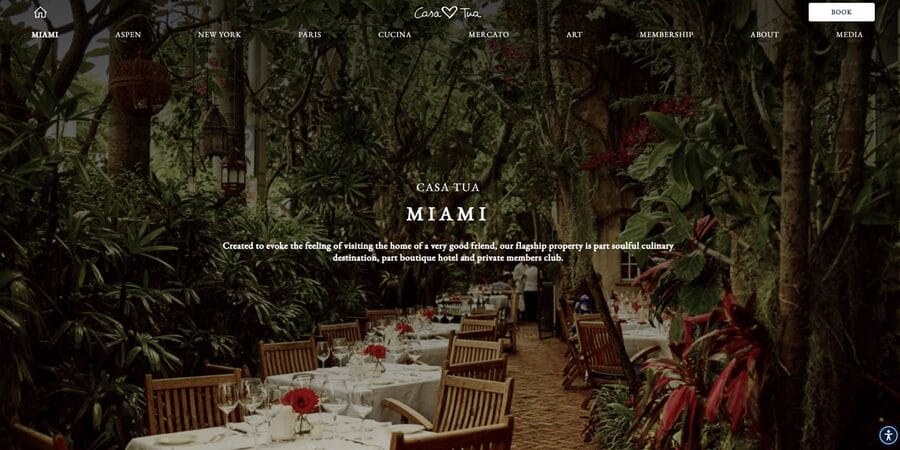
You can create customized content that highlights the unique identity of each neighborhood, such as the Cuban influence in Little Havana or the vibrant Haitian culture in Little Haiti.
Leveraging AI tools can streamline this process, allowing you to efficiently craft engaging, localized narratives.
Consider launching hyper-local social media campaigns, partnering with local influencers and introducing more interactive content.
5. Prioritize Customer Service And Quality Products
A notable 56% of users see customer service as an important factor in driving brand loyalty.
Building brand loyalty for businesses in The Tropical Paradise involves more than just simple transactions and flashy marketing — it calls for actionable, sincere and empathetic customer service.
This means going the extra mile when collecting user feedback, responding to complaints promptly and offering solutions that genuinely address customer needs.
For instance, Miami-based Bacardi promotes its flavorful and quality rum-based beverages through timely social media exchanges and useful cocktail recipes for its customers.
6. Introduce Loyalty Programs And Rewards
The average American consumer enrolls in 16.7 loyalty programs but actively participates in only 7.4.
To ensure your brand remains among the active few, focus on offering genuinely valuable rewards rather than simply providing discounts for future purchases.
Consider partnering with other local businesses to offer cross-promotional deals or unique experiences for loyal customers.
Additionally, incorporating gamification into your loyalty program can boost engagement and promote friendly competition among customers.
This could include features such as points, progress indicators, referral incentives or the option to choose rewards.
For example, the Miami Heat has a specialized rewards program for their season ticket holders, offering exclusive benefits such as gift cards, meet and greets with players and VIP access to events.

7. Create A Brand Community
Building brand loyalty in Miami starts with honest connection, conversation and omnichannel engagement.
Encouraging feedback, answering questions and engaging customers through social media and email marketing can strengthen positive brand associations and encourage repeat purchases.
Take the University of Miami as an example — it creates social media content that unifies, engages and resonates with its diverse college community.
It uses relatable, student-centric and brand-specific elements to appeal to its target demographic and create lasting brand loyalty in the Art Deco Haven.
Ultimately, the goal is to create a feedback process that feels seamless and respectful.
When customers see that their opinions lead to meaningful improvements or are publicly acknowledged, it strengthens their trust and connection with your brand.
A dialogue that feels personal and valued ensures customer participation is seen as a partnership and not a hassle.
Moreover, consumers who are emotionally invested and feel connected can turn into brand advocates to promote your business to others.
Consumers are twice as likely to stay loyal and advocate for brands they trust, so pay attention to how you address customer concerns and feedback.
8. Rely On User Analytics And Engagement
Brand loyalty in Miami starts with in-depth research on customer preferences, behaviors and purchasing patterns to determine how to effectively engage them.
Invest in user analytics and engagement tools that can help you gather valuable data on your target audience and their interactions with your brand.
This can help you identify what drives customer loyalty, what areas of your business need improvement and how to effectively market your products or services to your target demographic.
9. Use Social Proof And Testimonials
91% of users agree that local branch reviews shape their perception of big brands.
Reviews, testimonials and recommendations from others can influence Miami’s dynamic and diverse consumer base and define your brand’s reputation.
Encourage satisfied customers to leave reviews on platforms like Google My Business, Yelp or Trustpilot.
You can also incorporate user-generated content, such as customer photos or videos, into your social media strategy to showcase positive experiences with existing clients and attract new ones.
Additionally, partnering with local influencers or brand ambassadors who have a strong presence in the local community can also help boost your brand’s credibility and appeal to potential customers.
A highly popular influencer, Alix Earle, is often associated with the Miami Dolphins. She frequently shares her positive experiences with the team on social media, which helps strengthen the brand’s image and attract a wider audience.
10. Engage In Local Social Responsibility
88% of consumers want brands to help them make a difference and Miami’s opinionated and socially aware consumer base is no exception.
Participating in local social responsibility initiatives helps you connect with your community and make a positive impact and align your values with those of Miami consumers.
This could include sponsoring or participating in charity events, partnering with local non-profit organizations, or implementing sustainable and environmentally friendly practices in your business operations.
Take the Ritz-Carlton hotel as an example — it proudly flaunts its sustainability initiatives and philanthropic efforts to help preserve Florida’s natural resources.
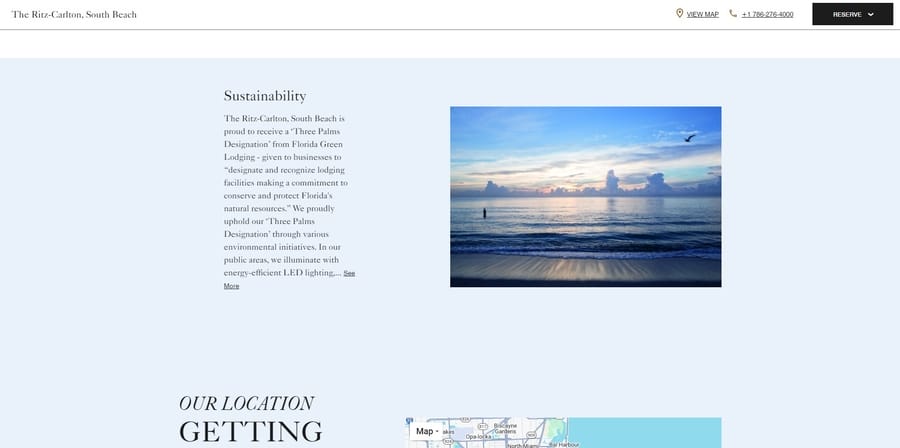
The Importance Of Building Brand Loyalty In Miami
Knowing how to build brand loyalty in Miami can present a significant competitive advantage and offer several benefits for your business, including:
- Repeat purchases: 60% of users are inclined to pay more for brands they’re loyal to as opposed to the competition. With a solid base of repeat customers, you can generate consistent revenue, boost your return on investment (ROI) and support long-term business growth.
- Word-of-mouth marketing: 81% of customers trust recommendations from friends and family more than traditional marketing. This kind of organic advertising holds significant value, especially in tightly knit communities in the South Florida Hub.
- Cost-efficient strategy: Acquiring new customers can be costly, but loyal ones can help offset those expenses. With brand loyalty, you can focus on retaining existing customers rather than solely on attracting new ones, which minimizes acquisition costs and boosts profitability.
- Reduced churn rate and cart abandonment: With a global shopping cart abandonment rate of 70.19%, Miami brands face a significant challenge in retaining customers through the checkout process. You can reduce the likelihood of customers leaving for competitors by building a more stable customer base and higher revenue over time.
- Competitive advantage: Competition in Miami is fierce and unforgiving, as brands from across the globe seek to capitalize on the Gold Coast. In industries with numerous options, strong brand loyalty can become your greatest competitive asset.
- Future-proof brand expansions: With dedicated customers come expansion opportunities. If you plan to take your brand beyond Miami or introduce new product lines, your existing following can serve as a launching pad for new business endeavors.
How To Measure Brand Loyalty Of Your Miami Brand
While the theoretical benefits of building brand loyalty in The Gateway to the Americas sound convincing, you need to measure tangible results to see if your efforts are paying off.
Keep a close eye on the following KPIs to determine whether your brand loyalty strategy is successful:
- Customer Effort Score (CES): Determines how much effort a customer needs to put in to interact with your brand, such as making a purchase or resolving an issue. A lower effort score translates to higher satisfaction, which in turn fosters loyalty.
- Net Promoter Score (NPS): Gauges how likely customers are to recommend your brand to others on a scale of 0-10. High scores generally indicate loyal customers who act as unpaid promoters, which can be a valuable asset in Miami’s interconnected social circles.
- Repeat Purchase Rate (RPR): Determines how often customers return to make a purchase. A high RPR indicates loyal customers who trust your brand and are willing to spend their money on your products or services. Vice City’s diverse population means that businesses often need to work harder to get clients to return, especially as new competitors constantly enter the market.
- Customer Lifetime Value (CLV): Estimates the total revenue a customer generates over their lifetime relationship with your brand. Fostering a higher CLV can result in a more predictable revenue stream and increased profitability.
- Upsell Ratio: The Upsell Ratio tracks the percentage of customers who not only make a purchase but also upgrade to higher-tier products or add-ons. For example, a Miami-based fitness studio could review how many members upgrade to premium plans or purchase add-on classes to determine the upsell ratio.
Build Brand Loyalty In Miami With Digital Silk
Miami’s population is multicultural, tech-savvy and experience-driven, which may offer guidance for your branding strategy but also lead you astray if not careful.
At Digital Silk, our branding and digital strategists work closely with our Miami-based clients to create memorable brand experiences that foster loyalty and connect with the diverse local audience.
As an end-to-end web design agency, our services include but aren’t limited to:
Need help with your brand strategy in Miami?
Contact our team, call us at (800) 206-9413 or fill in the Request a Quote form below to schedule a consultation.
"*" indicates required fields


